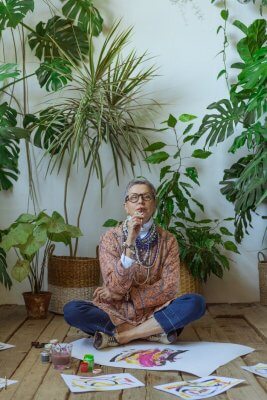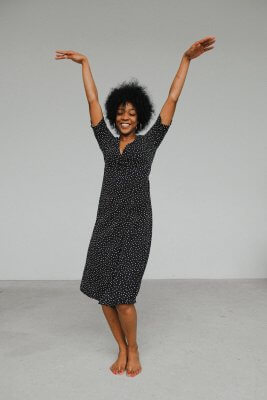What is Expressive Arts Therapy and Can it Help You?

photo by Ron Lach at Pexels
Heard of expressive arts therapy? But assumed it couldn’t be a serious form of psychotherapy?
Think again. It’s a recognised and recommended intervention that requires no previous experience with creativity or art, and is suitable for all ages.
What is expressive arts therapy?
Expressive arts therapy uses creativity to treat mental health issues, emotional problems, and life challenges.
The idea is that the process of making something works as a way for us to communicate with ourselves and find self-expression. And it allows us to understand our own potential and personal power to create not just art, but our own lives.
If it’s helpful, think of expressive arts therapy as counselling that doesn’t need to involve much verbal expression. So in this way it’s the opposite to other forms of psychotherapy.
What types of art are used during an art therapy session?
Again, it’s about the process of creating. Not about adhering to one form or style of art.
Expressive arts therapy can encompass painting, drawing, sculpture, collage. Working with clay, words, dance, drama, movement, singing. Really anything that is about making something.
What is a typical expressive arts therapy session like?
There is not a ‘typical’ way for an art therapy session to be. Art therapy can be done in groups, or alone. It can involve your therapist giving you a certain goal for a creative task, such as asking you to draw your feelings around a certain situation. Or it could involve free expression to see what comes forth.

photo by Anna Shvets on Pexels
And art therapy might also be integrated with other forms of psychotherapy. You might, for example, be working with a therapist who also trained in psychodynamic therapy, or CBT. They would integrate methods from these therapies with art in your sessions.
What issues can art therapy help with?
Here in the UK art therapies are officially recommended by the National Institute for Health and Care Excellence (NICE). They recommend them for children, young people, and adults with schizophrenia and psychosis. NICE also suggests creative therapies as a helpful treatment for children and young people recovering from abuse or with chronic fatigue syndrome, and as a wellbeing activity for those 65 and over.
With its focus on creativity over verbal expression, art therapy is also often used for those with learning issues that affect their communication. This includes autism.
Other issues that might be helped with expressive arts therapy include:
- addictions
- ageing
- anger issues
- anxiety and anxiety disorders
- borderline personality disorder
- childhood trauma and neglect
- communication problems
- depression
- eating disorders
- emotional difficulties
- illness and medical conditions
- lack of confidence
- loneliness
- low sense of self
- post-traumatic stress disorder (PTSD)
- relationship issues
- stress
- work problems.
But is it a serious intervention?
Art contributed to the forms of talk therapy that are popular today, and how they approach treatment for difficult or traumatic childhoods.
In 1973, established psychoanalyst Alice Miller announced she had discovered her childhood history. But not through the process of psychoanalysis, rather through spontaneous painting. Shunned at the time by the psychoanalytical community for the questions this threw on its processes, she ended up writing a book.
“The Drama of Being a Child: The Search for the True Self” went on to became a sensation and bestseller. It contributed to our current understanding of the causes and effects of abuse and neglect on children and on society at large.
And note that here in the UK the National Health Services (NHS) have recognised art therapy as a profession since 1997.
What does research have to say about art as therapy?
 It can be difficult to do rigorous research on the effects of creative arts therapy because it’s an umbrella therapy. So many types of creating are used, and in different ways. Sessions tend to be unique.
It can be difficult to do rigorous research on the effects of creative arts therapy because it’s an umbrella therapy. So many types of creating are used, and in different ways. Sessions tend to be unique.
For example, an overview of six research studies on the effects of art therapy on trauma symptoms [1] concluded that the quality of the studies was inconsistent.
Even so, more than half the studies reported a significant decreased in trauma symptoms. And one study found a clear connection between arts therapy and a significant decrease in depression.
As for the effects of making art on stress, a small but interesting study [2]found that 45-minutes of making art significantly lowered cortisol levels in participants.
A brief history of art therapy
Alice Miller used art to change our understanding of child abuse. But she was not the point that creative art therapies took off from.
Creative art therapies were integrated with therapies far earlier. Carl Jung himself experimented with creativity and integrated it into his work, such as his strong interest in drawing mandalas. But creative art therapy began to receive recognition in England and America more in the 1940s, with the work of people like psychoanalyst Margaret Naumburg.
How do I find an art therapist?
It’s important you find an art therapist who is properly trained and registered.
Here in the UK art therapy is an MA program at university. And your therapist should be registered with the Health and Care Professions Council (HCPC). If you aren’t sure about a therapist’s qualifications, don’t feel nervous to ask before booking. It’s your right to know their training and what registered bodies they are part of.
Still have a question about art therapy, or want to share your experience? Use the comment box below.
FOOTNOTES
[1] Schouten KA, de Niet GJ, Knipscheer JW, Kleber RJ, Hutschemaekers GJM. The Effectiveness of Art Therapy in the Treatment of Traumatized Adults: A Systematic Review on Art Therapy and Trauma. Trauma, Violence, & Abuse. 2015;16(2):220-228. doi:10.1177/1524838014555032.
[2] Kaimal G, Ray K, Muniz J. Reduction of cortisol levels and participants’ responses following art making. Art Therapy. 2016;33(2):74-80. doi:10.1080/07421656.2016.1166832.




